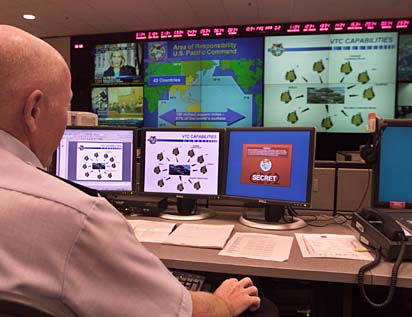
DENNIS ODA / DODA@STARBULLETIN.COM
Air Force Capt. Tony Snodgrass sits at one of the information-management stations in the new Nimitz-MacArthur Pacific Command Center. Besides looking at their own informational graphics, staffers monitor two cable news stations, as seen in the upper left two screens. The NMPCC is the new command headquarters for the commander of the U.S. Pacific Command, Adm. Thomas Fargo. The 274,500-square-foot building was built at Camp Smith to meet 21st century information technology and security requirements.
Pacific Command
gets wiredIts new headquarters bursts with
the latest information technology
and communication systems
Adm. Thomas Fargo's new $152 million Pacific Command headquarters is wired: State-of-the-art information technology links Camp Smith with the Pentagon, the White House situation room, and 43 Asian and Pacific Rim countries that cover an area of over 100 million square miles.
Center facts
Design-build contract awarded: 2000
Building construction completed: 2003
Dedication: April 14, 2004
Cost: $152 million (building: $86 million)
Size: 274,500 square feet
Occupants: 1,300
Contractor: Dick Pacific
Army Maj. Gen. Ron Lowe, Pacific Command's chief of staff, described the building, which reflects the architectural style of the 1920s, as being more than "concrete and furniture."
Lowe said there are 12,000 data channels and the latest fiber-optic network in the 274,500-square-foot building to serve the 1,300 people there so they can communicate with each other.
"But the communication is not only within the building, but throughout our AOR (area of operation), the White House and the Pentagon," Lowe said.
"In the military, this is as high-tech as it gets anywhere," he added.
Dedication of headquarters of the largest geographical combatant command in the U.S. military -- named the Nimitz-MacArthur Pacific Command Center -- is slated to take place April 14.
Named after Fleet Adm. Chester Nimitz, who commanded the Pacific in World War II, and Gen. Douglas MacArthur, Southwestern Pacific commander, it is located across the street from the building that has served as its headquarters at Camp Smith since 1957.
A four-story atrium, a grand staircase and numerous security barriers greet visitors as they enter the lobby.
Two floors are underground, including the military's highly secretive Special Operations Command, which shares basement quarters with the Pacific Command's intelligence section.
All offices are treated as secret classification areas and only those with special security badges and access codes can gain entrance.
It is the first major development on a 220.5-acre facility at Camp Smith that was designated as Navy Hospital Aiea Heights in 1941. Throughout World War II, the 1,650-bed Aiea Hospital served thousands of wounded sailors and Marines. The old hospital building will revert back to its original tenants -- headquarters for Marine Forces Pacific and Fleet Marine Force.
Lowe noted that when the Pacific Command moved into the hospital building nearly 50 years ago, telephones were the major means of communication.
"Today, there are more than 100 different communication systems in this building," Lowe told reporters who were given a tour Friday of several restricted areas, such as the Joint Operations Center, the command's nerve center that is normally not open to the public.
Twenty-five to 30 people work in the operations center, which is located underground, monitoring the entire Pacific area 24 hours a day, said Marine Col. Robert Clinton, its director.
There are 88 desks, each equipped with three flat-screen monitors, in the 1,500-square-foot tiered conference room.
As part of Friday's briefing, reporters were shown on a 40-by-10-foot video monitor a map of the Pacific, which included an overlay of all of the commercial airlines and merchant vessels in the area.
"In a crisis, we can easily locate, find and track any vessel in our AOR whether they want to or not," Clinton said.
The video monitor also simultaneously projected two of the three cable news networks, as well as a constant picture of world weather.
Clinton said there are five means of communications in the operations center -- phone, three computer networks (unclassified, classified and top secret), radio to contact any aircraft or ship, secure computer chat rooms and video teleconferencing.
All this technology gives the Pacific Command and Fargo the ability to communicate with commanders in places as far as Japan and South Korea, ships at sea or planes in flight, embassies and consulates in foreign countries, the Pentagon and the White House situation room, Clinton said.
This also means that even when Fargo is traveling, as he was last week to testify before Congress, his Pacific Command has all five means to keep in contact with him.
"We never lose contact with the commander," Clinton said.
This technology allows Clinton to get all the information he needs in "real time" to help Fargo make a decision.
"In the event that something happens in our AOR and I don't have the expertise on the floor," he said, "this is a very good tool for us to reach back to D.C. (District of Columbia), or Korea or Japan or anywhere to get to that person and talk to him in real time. ... That beats a fax, that beats sending e-mails back and forth. ... That cuts down the time to get real data and pass on that information to the commander."
Navy Capt. Bob Kelly, who headed the construction of the building, said it incorporates a design developed as a result of the Sept. 11, 2001, terrorist attacks on the Pentagon by including reinforced support structures.
Backup electrical power is provided by two 1,000-kilowatt generators.
Groundbreaking ceremonies were held Feb. 20, 2001, when Adm. Dennis Blair headed the command. When Fargo took office a year later, his orders were to stay within budget and finish the job on time with his goal -- a test of the new technology during a readiness exercise held in South Korea at the end of March.
"And we met that goal," Lowe said.
